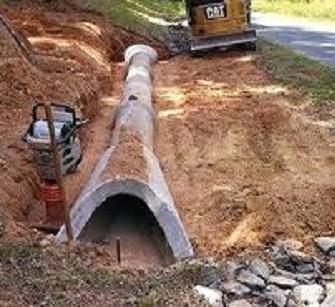Mastering Culvert Installation: Boost Your Land Drainage Initiatives
From selecting the right materials to implementing ideal practices, mastering culvert installment can considerably improve the effectiveness and longevity of your land drain system. By comprehending the ins and outs of culvert setup, you can maximize your drain initiatives and make sure lasting land use practices.
Relevance of Culvert Installment
Making certain correct culvert installation is extremely important for keeping reliable land water drainage systems. Culverts play an important duty in managing water flow, protecting against erosion, and keeping the structural integrity of roadways, bridges, and various other infrastructure. Proper setup of culverts helps to funnel water far from roadways and structures, lowering the danger of flooding and water damage. In addition, well-installed culverts aid in protecting against sediment accumulation, which can lead to blockages and lowered water flow.
Appropriate Sizing and Positioning

Appropriate placement of culverts is equally crucial. Culverts should be placed at the most affordable factor of the area calling for water drainage to make certain efficient water flow. Furthermore, they ought to be installed perpendicular to the all-natural slope of the land to avoid blockages and permit smooth water flow. Strategic placement can aid stop waterlogging, soil erosion, and road damage, ensuring the long life and effectiveness of the land water drainage system.
Product Choice Tips
Picking the appropriate products is critical in guaranteeing the toughness and capability of culverts for effective land drain systems. When selecting materials for culvert installation, it is essential to think about elements such as the water flow rate, soil make-up, and ecological problems of the website.
Among the most common materials made use of for culverts is corrugated steel (Tree removal). Corrugated metal culverts are resilient, cost-efficient, and simple to set up. They are ideal for areas with high water flow prices and can withstand heavy tons. One more popular option is concrete culverts, which supply outstanding toughness and long life. Concrete culverts are excellent for locations susceptible to corrosion or when a much longer life span is desired.
For ecologically delicate areas, plastic culverts might be favored. In addition, in areas where all-natural appearances are essential, products like stone or wood can be utilized to build culverts that blend flawlessly into the surroundings.
Setup Strategies and Best Practices
Given the essential importance of product choice in ensuring the capability and longevity of culverts, the installation methods and best practices play a critical role in the overall success of land drainage systems. Proper installment is crucial to avoid concerns such as leaks, breaks down, or clogs that can endanger the efficiency of the culvert.

During installation, care should be required to line up the culvert correctly and offer appropriate support to protect against contortion. Backfilling must be done gradually and compressed in layers to prevent useful reference spaces and negotiation. Appropriate compaction is important to stop shifting or sinking of the culvert over time.

Maintenance and Long-Term Care
Implementing a comprehensive upkeep strategy is crucial for making certain the long life and reliable efficiency of culverts in land drain systems. Routine assessments ought to be performed to look for any indications of damages, clogs, or erosion that could jeopardize the functionality of the culvert. Cleaning particles such as fallen leaves, branches, and debris is crucial to stop obstructing and keep the flow capability of the culvert. Greenery control around the culvert location is additionally essential to stop origins from creating structural damages.
Furthermore, attending to any concerns without delay and making necessary repairs or replacements can aid prevent expensive problems in the future. site web Regular upkeep tasks may include cleaning, repairing joints, strengthening inlet and electrical outlet frameworks, and guaranteeing proper slope and positioning of the culvert. Keeping thorough documents of maintenance activities, examinations, and fixings is crucial for tracking the condition of the culvert gradually and preparing future maintenance demands. By staying positive and applying a complete upkeep plan, land drainage systems can operate properly and successfully for many years to come.
Conclusion
Finally, understanding culvert setup is essential for efficient land drainage. Proper sizing, placement, material selection, installation strategies, and maintenance are essential factors to take into consideration. By adhering to best methods and implementing lasting treatment strategies, landowners can increase their drain efforts and make certain the durability and functionality of their culverts. It is important to prioritize these facets to stop water damages, disintegration, and other expensive issues on the residential property.